- National annual average inflation accelerates in 2016
- The annual average consumer price index (CPI) in 2016 was recorded at 144.0 for the Philippines, 133.4 for the National Capital Region (NCR) and 147.4 for areas outside NCR (AONCR). (Table 1)
- The annual average inflation at the national level went up by 1.8 percent in 2016. It was registered at 1.4 percent in 2015. Higher annual average rates during the year were posted in the indices of alcoholic beverages and tobacco; health; recreation and culture; and restaurant and miscellaneous goods and services. The annual average changes in the indices of transport and communication also picked up during the year. In 2016, the highest annual average inflation at the national level was observed in December at 2.6 percent while the lowest was in February at 0.9 percent. (Table 1.1, Table 2.1 and Figure 1)

- Regional inflation generally pick up during the year

- The annual average inflation in NCR climbed by 1.2 percent in 2016. It was pegged at 1.0 percent in 2015.
- In AONCR, the annual average inflation likewise increased by 1.9 percent in 2016 compared with 1.5 percent in 2015.
- Twelve regions in AONCR registered higher annual average growth rates. The highest annual average growth was observed in Region VII (Central Visayas) and Region XI (Davao Region) at 3.2 percent while the lowest was noted in Region IV-A (CALABARZON) at 0.9 percent. (Table 1.1 and Figure 2)
- Highest inflation is recorded in alcoholic beverages and tobacco index
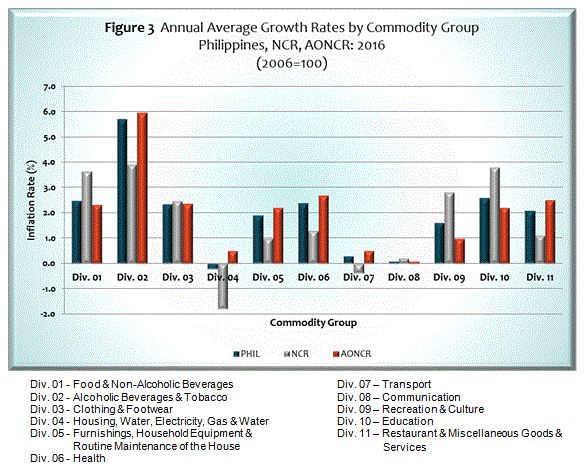
- Food and non-alcoholic beverages (3.6%)
- Alcoholic beverages and tobacco (3.9%)
- Communication (0.2%)
- Recreation and culture (2.8%)
- Restaurant and miscellaneous goods and services (1.1%)
Slower annual average increases were however, recorded in the indices of clothing and footwear at 2.5 percent; health, 1.3 percent; and education, 3.8 percent. The annual average growth in furnishing, household equipment and routine maintenance of the house index remained at 1.0 percent. The indices of housing, water, electricity, gas and other fuels and transport correspondingly posted negative annual average rates at -1.8 percent and -0.4 percent.
In AONCR, the indices of the following commodity groups exhibited faster annual average increments in 2016:
- Alcoholic beverages and tobacco (6.0%)
- Health (2.7%)
- Recreation and culture (1.0%)
- Restaurant and miscellaneous goods and services (2.5%)
From negative annual average rates in 2015, the indices of housing, water, electricity, gas and other fuels and transport both went up by 0.5 percent in 2016 and communication, 0.1 percent. On the other hand, annual average add-ons in the indices of food and non-alcoholic beverages and clothing and footwear both decelerated to 2.3 percent and education, 2.2 percent. That for furnishings, household equipment and routine maintenance of the house index remained at 2.2 percent. (Table 1.1 and Figure 3)
- By Commodity Group, by Region
- Food and Non-Alcoholic Beverages

In NCR, the annual average growth of food and non-alcoholic beverages index accelerated by 3.6 percent in 2016. Meanwhile, a slower annual average rate of 2.3 percent was observed in AONCR as 11 regions exhibited lower annual average mark-ups during the year. In addition, Region V (Bicol Region) registered an annual average decline of 0.1 percent, the lowest rate in 2016. On the other hand, the highest annual average inflation was noted in ARMM (Autonomous Region in Muslim Mindanao) at 3.8 percent. (Table 1.1 and Figure 4)
Among the food groups, the highest annual average inflation was seen in vegetables index at 11.0 percent in NCR and 11.3 percent in AONCR. For the Philippines, it was recorded at 11.2 percent. On the other hand, the lowest was posted in rice index at -0.6 percent in NCR and -0.2 percent in AONCR. At the country level, the group's index had a 0.3 percent annual average decrease in 2016. (Table 3.1)
- By Food Group
The annual average change of the rice index in AONCR went down by 0.2 percent in 2016 as 14 regions posted either negative or slower annual average rates. The lowest annual average growth was noted in Region V (Bicol Region) at -4.6 percent. Annual average adjustment of rice index in NCR, likewise, fell by 0.6 percent during the period. The price of NFA rice in the area dropped from an average price of 26.09 pesos per kilogram in 2015 to 25.51 pesos per kilogram in 2016. Moreover, regular milled and glutinous rice were also generally priced lower during the year. At the national level, the annual average rate of the group’s index dropped by 0.3 percent.
Double-digit annual average mark-up was posted in corn index in NCR at 39.2 percent in 2016. Similarly, the annual average rate of the group’s index in AONCR inched up by 0.9 percent. The decrease in the production of corn brought about by “El Niño” and the strong typhoons that ravaged the county in 2016, such as “Karen” and “Lawin”, caused its lower supply in the markets. Hence, prices of corn moved upward during the year. For the Philippines, the annual average growth of corn index jumped by 2.2 percent.
The general upward price adjustments in fresh meat such as beef and chicken raised the meat index in NCR by 3.1 percent. Higher prices of processed and canned meat in the area also contributed to the uptrend. Meanwhile, the meat index in AONCR posted a slower annual average increment of 1.2 percent. Higher annual average upticks in six regions were tempered by the lower or negative annual average rates recorded in 10 regions. Enough supply of pork generally pushed down its prices in the markets. At the national level, the annual average growth of the meat index settled to 1.7 percent in 2016, the same rate registered in 2015.
The hot weather conditions experienced in the first semester of 2016 limited the volume of production of selected fish species. Reduced fishing trips due to occurrence of typhoons in the second semester effected the lower supply of fish in the markets. Hence, the annual average growth of the fish index in NCR climbed by 6.4 percent during the year. Similarly, the annual average change of the group’s index in AONCR rose by 3.3 percent. This was, however, slower than its previous year’s growth of 4.9 percent as 12 regions registered either lower or negative annual average rates. For the Philippines, the annual average increase of the fish index eased to 3.7 percent in 2016.
The annual average add-ons of the indices of milk, cheese and egg in NCR slowed down to 1.3 percent and AONCR, 1.8 percent. Lower annual average price gains in milk, cheese and egg were observed in most of the regions. The annual average growth of the group’s index at the country level slid to 1.7 percent in 2016 compared from 2.7 percent in 2015.
The acceleration in the prices of cooking oil in many regions raised the annual average rate of oils and fats index in NCR by 3.5 percent and in AONCR, 2.5 percent. Higher prices of butter and margarine in many regions also contributed to the uptrend. At the national level, the group’s index picked up by 2.7 percent.
The annual average inflation of the fruits index in NCR soared by 10.3 percent in 2016. Banana, mango, avocado and apple registered higher annual average price increments during the year. In AONCR, the annual average growth of the fruits index also went up but at a slower rate of 5.0 percent. The national average index rose by 6.0 percent in 2016 from 7.2 percent in 2015.
Double-digit annual average inflation rates were posted in the indices of vegetables in NCR at 11.0 percent in 2016 and AONCR, 11.3 percent. This was primarily due to higher prices of garlic, onion, cabbage and tomato. Unfavorable weather conditions experienced in 2015 and 2016 generally lowered their production during these years. Among the regions in AONCR, the highest annual average rate was recorded in Region II (Cagayan Valley) at 18.0 percent. For the Philippines, the group’s index advanced by 11.2 percent in 2016 from 2.7 percent in 2015.
The index for sugar, jam, honey, chocolate and confectionery exhibited faster annual average mark-ups of 4.3 percent in NCR and 4.4 percent in AONCR in 2016. Prices of sugar generally went up during the year due to lower production of refined sugar. At the country level, the group’s index gained by 4.4 percent.
The annual average inflation of food products not elsewhere classified index in 2016 dropped by 1.3 percent in NCR brought about by lower prices of ginger. A slower annual average increment of the group’s index at 0.1 percent was also observed in AONCR. Price increases in some condiments and seasonings in many provinces were tempered by the big price declines of ginger in most of the regions. For the Philippines, the annual average growth of corn index went down by 0.2 percent. (Table 3.1)
- Alcoholic Beverages and Tobacco
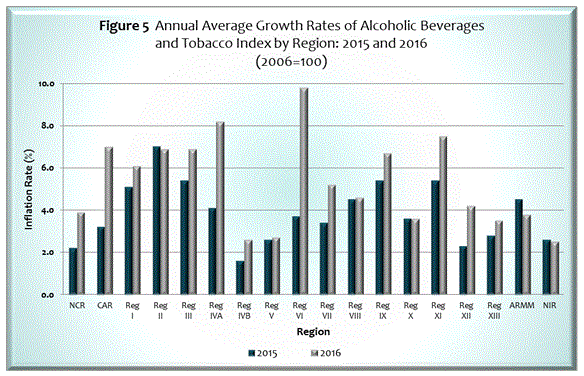
Upward price movements in cigarettes and alcoholic beverages pushed up the annual average inflation of alcoholic beverages and tobacco index in NCR by 3.9 percent in 2016 and in AONCR, 6.0 percent. The highest annual average rate in the group’s index was registered in Region VI (Western Visayas) at 9.8 percent while the lowest was in NIR (Negros Island Region) at 2.5 percent. (Table 1.1 and Figure 5)
- Clothing and Footwear

Price hikes in selected ready-made apparel and footwear were noted during the year. Thus, the annual average rate in clothing and footwear index in NCR accelerated by 2.5 percent and in AONCR, 2.3 percent. These were however, slower than their corresponding previous year’s growths of 3.0 percent and 2.4 percent. The highest annual average increase of 6.3 percent was seen in Region XI (Davao Region)) while the lowest rate of 0.8 percent was in NIR (Negros Island Region). (Table 1.1 and Figure 6)
- Housing, Water, Electricity, Gas and Other Fuels

Lower charges in electricity rates and price reductions in LPG and kerosene were generally noted in 2016. These factors contributed to the 1.8 percent annual average decrease in the index for housing, water, electricity, gas and other fuels in NCR. Meanwhile, in AONCR, higher rental rates of dwelling units and increases in the prices of selected construction materials in some regions were tempered by lower charges in electricity rates and downward price adjustments in LPG and kerosene in many regions. Hence, the annual average growth of the group’s index in AONCR in 2016 was slower at 0.5 percent. Region IV-A (CALABARZON) recorded the lowest annual average rate of -2.0 percent while the highest was seen in Region IX (Zamboanga Peninsula) at 7.7 percent. (Table 1.1 and Figure 7)
- Furnishings, Household Equipment and Routine Maintenance of the House
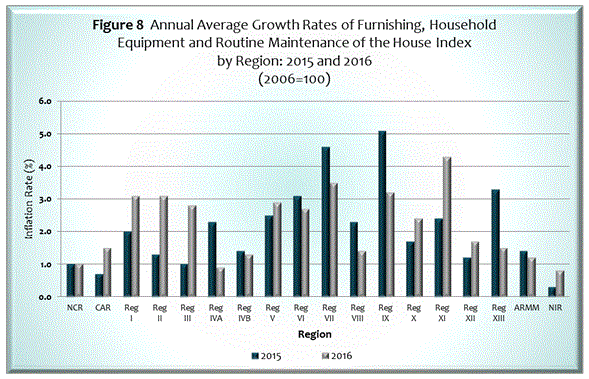
In 2016, the annual average growths in the indices of furnishing, household equipment and routine maintenance of the house in NCR and AONCR remained at 1.0 percent and 2.2 percent, respectively. Higher salaries of domestic helpers and increments in the prices of some articles for cleaning were recorded in selected regions. The highest annual average rate at 4.3 percent was registered in Region XI (Davao Region) while the lowest at 0.8 percent was posted in NIR (Negros Island Region). (Table 1.1 and Figure 8)
- Health
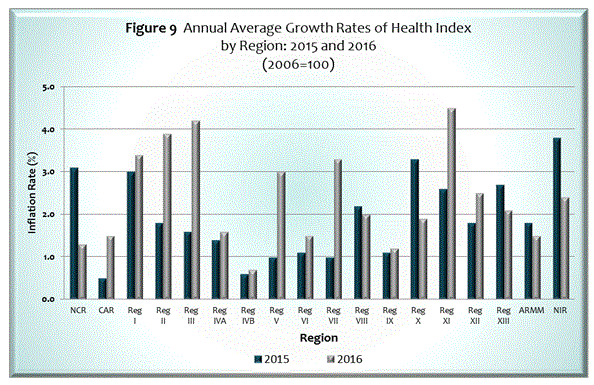
On the average, charges for medical and hospital services were lower in 2016 compared with 2015. Thus, the annual average inflation of the health index in NCR decelerated to 1.3 percent during the year. On the other hand, the annual average growth of the health index in AONCR accelerated by 2.7 percent in 2016 due to higher price gains in medical products and increased charges for medical and hospital services. The highest annual average growth of 4.5 percent was seen in Region XI (Davao Region) while the lowest at 0.7 percent was noticed in Region IV-B (MIMAROPA). (Table 1.1 and Figure 9)
- Transport
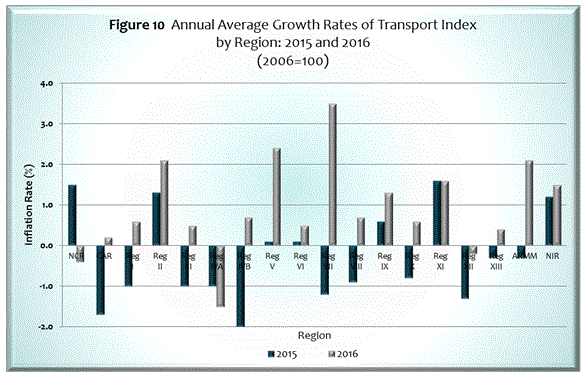
Lower prices of gasoline and diesel primarily pushed down the annual average rate of the transport index in NCR by 0.4 percent during the year. Rollbacks in jeepney and taxi fares in the area also contributed to the downtrend. Meanwhile, the annual average growth of the transport index in AONCR generally moved up by 0.5 percent after posting a 0.5 percent annual average decline in 2015. This was due to higher air and ship fares recorded in many regions. The highest annual average rate during the period at 3.5 percent was posted in Region VII (Central Visayas) while the lowest at -1.5 percent was observed in Region IV-A (CALABARZON). (Table 1.1 and Figure 10)
- Communication
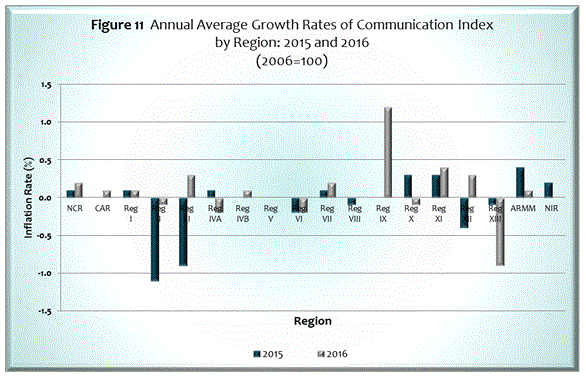
The annual average rate in communication index in NCR inched up by 0.2 percent in 2016 due to higher charges in telephone services and repairs of cellular phones. Likewise, the annual average growth of the group’s index in AONCR recorded a 0.1 percent growth in 2016 from -0.2 percent in 2015. This was brought about by higher charges for telephone services. Region IX (Zamboanga Peninsula) had the highest annual average rate of 1.2 percent while the lowest was in Region XIII (Caraga) at -0.9 percent. (Table 1.1 and Figure 11)
- Recreation and Culture
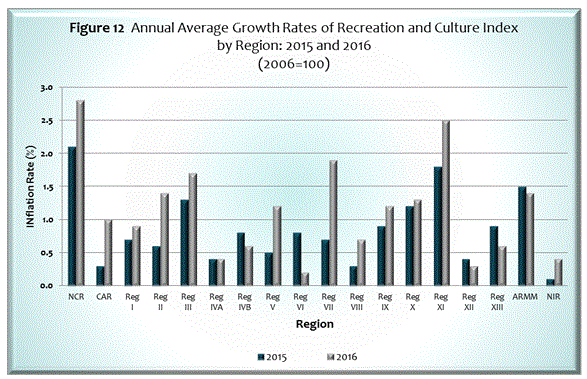
On an annual basis, selected audio-visual, photographic and information processing equipment were generally priced higher in 2016. In addition, movie admission fees in cinemas also went up in many regions. These factors resulted to higher average annual inflation in recreation and culture index in NCR at 2.8 percent and in AONCR, 1.0 percent. Region XI (Davao Region) exhibited the highest annual average growth of 2.5 percent while Region VI (Western Visayas) had the lowest at 0.2 percent. (Table 1.1 and Figure 12)
- Education

In 2016, the annual average growth of the education index in NCR decelerated to 3.8 percent and in AONCR, 2.2 percent. This was due to lower annual hikes in school tuition fees in all the regions except Region II (Cagayan Valley) and Region X (Northern Mindanao). The lowest annual average rate was seen in Regions V (Bicol Region) and XII (SOCCSKSARGEN) at 0.8 percent while the highest was recorded in CAR at 4.4 percent. (Table 1.1 and Figure 13)
- Restaurants and Miscellaneous Goods and Services

The annual average inflation of restaurant and miscellaneous goods and services index in NCR picked up by 1.1 percent and in AONCR, 2.5 percent. This can be attributed to price increases in meals eaten outside the home during the year. Selected items for personal care and effects were also priced higher in many regions. Region II (Cagayan Valley) recorded the highest annual average growth of 4.6 percent while NIR (Negros Island Region) had the lowest annual average rate at 0.7 percent. (Table 1.1 and Figure 14)
__________________________________________________________________________________________________________________________
CPIs and inflation rates by province and selected city are also available upon request at Philippine Statistics Authority, Economic Sector Statistics Service, Price Statistics Division (Telephone Number: 376-19-59).
